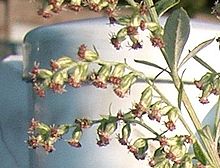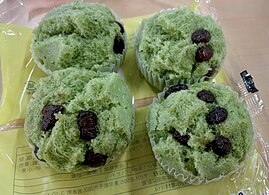| Artemisia princeps | |
|---|---|

| |
| Scientific classification | |
| Kingdom: | Plantae |
| Clade: | Tracheophytes |
| Clade: | Angiosperms |
| Clade: | Eudicots |
| Clade: | Asterids |
| Order: | Asterales |
| Family: | Asteraceae |
| Genus: | Artemisia |
| Species: | A. princeps |
| Binomial name | |
| Artemisia princeps Pamp. | |
| Synonyms | |
| |
Artemisia princeps, also commonly called yomogi, Japanese mugwort, Korean wormwood, Korean mugwort or wormwood in English, is an Asian plant species in the sunflower family, native to China, Japan and Korea. It is a perennial, very vigorous plant that grows to 1.2 meters. This species spreads rapidly by means of underground stolons and can become invasive. It bears small, buff-colored flowers from July to November which are hermaphroditic, and pollinated by wind. The leaves are feather shaped, scalloped and light green, with white dense fuzz on the underside.
Distribution and habitat
Artemisia princeps is native to China, Japan and Korea. It has been introduced into Belgium and the Netherlands. It grows in a variety of habitats including roadsides, slopes, valleys, and riverbanks.
As food
Leaves and young seedlings can be eaten raw or cooked. They can also be used in salads and soups after removal of the bitterness.
Japan
In Japan the herb is used to flavor glutinous rice dumplings called kusa mochi (草餅) or yomogi mochi (蓬餅), or rice flour dumplings called kusa dango (草団子). The young leaves can be lightly boiled before being pounded and added to impart a pleasant colour, aroma and flavour. Because of this use, the Artemesia plant is also called mochigusa (餅草, though it is also called mogusa in reference to its use in moxibustion). The plant is also actively grown in the state of Hawaii, and used for making the herbal mochi by residents of Japanese descent.
The leaves are occasionally blanched and added to soups or rice in Japanese cuisine.
-
 Kusa mochi
Kusa mochi
-
 Kusa mochi being made by pounding
Kusa mochi being made by pounding
-
 Kusa dango (rice dumplings) with anko
Kusa dango (rice dumplings) with anko
-
 Yomogi muffins
Yomogi muffins
Korea
Mugwort, referred to as ssuk (쑥) in Korean, is widely used in Korean cuisine as well as in traditional medicine (hanyak). In spring, which is the harvesting season, the young leaves of mugwort are used to prepare savory dishes such as jeon (Korean-style pancakes), ssuk kimchi, (쑥김치), ssukguk (쑥국, soup made with ssuk). Most commonly, however, fresh mugwort as well as dried leaves ground into powder are a characteristic ingredient in various types of tteok (rice cakes). Today, ssuk also adds flavor and color to more contemporary desserts and beverages, e.g. ice cream, breads, cakes, mugwort tea (ssukcha 쑥차) and ssuk latte (쑥라떼).
-
 Ssuk (Korean mugwort)
Ssuk (Korean mugwort)
-
 Aetang (mugwort dumpling soup)
Aetang (mugwort dumpling soup)
-
 Ssuk-beomuri (mugwort rice cakes)
Ssuk-beomuri (mugwort rice cakes)
-
 Ssuktteok (mugwort rice cakes)
Ssuktteok (mugwort rice cakes)
-
 Ssukcha (mugwort tea)
Ssukcha (mugwort tea)
China
In China it is known as huanghua ai (黄花艾, literally yellow-flower mugwort).
As medicine
Artemisia princeps is one of the species of mugwort used as in moxibustion, a traditional medical practice of China, Korea, Mongolia, Tibet, Nepal and Vietnam.
In culture
In Korea, it is called ssuk (쑥) or tarae ssuk (타래쑥) which is deeply related to Dangun Sinhwa (단군신화), legend of Gojoseon, the first Korean kingdom. To the ancient people in Korea, ssuk was one of the foods that was believed to have medicinal or religious value. In the foundation myth of Gojoseon in 2333 BCE, eating nothing but 20 cloves of garlic and a bundle of ssuk for 100 days let a bear be transformed into a woman.
See also
References
- The Plant List Artemisia princeps Pamp.
- Hiramatsu, Naoko; Xiufen, Wang; Takechi, Ryusuke; Itoh, Yoshimi; Mamo, John; Pal, Sebely (2004). "Antimutagenicity of Japanese traditional herbs, gennoshoko, yomogi, senburi and iwa-tobacco". BioFactors. 22 (1–4): 123–125. doi:10.1002/biof.5520220124. ISSN 1872-8081. PMID 15630266. S2CID 40718791.
- ^ Hirano, Akiko; Goto, Masashi; Mitsui, Tsukasa; Hashimoto-Hachiya, Akiko; Tsuji, Gaku; Furue, Masutaka (September 2017). "Antioxidant Artemisia princeps Extract Enhances the Expression of Filaggrin and Loricrin via the AHR/OVOL1 Pathway". International Journal of Molecular Sciences. 18 (9): 1948. doi:10.3390/ijms18091948. PMC 5618597. PMID 28892018.
- ^ "Japanese mugwort". hosho.ees.hokudai.ac.jp. Retrieved 2021-08-10.
- Small, Ernest; et al. (National Research Council Canada) (2006). Culinary Herbs. NRC Research Press. p. 197. ISBN 9780660190730.
- ^ Kirshner, Hannah (2021). Water, Wood, and Wild Things: Learning Craft and Cultivation in a Japanese Mountain Town. Penguin. pp. 138–141. ISBN 9781984877529.
- ^ Korea National Arboretum (2015). English Names for Korean Native Plants (PDF). Pocheon: National Arboretum. p. 361. ISBN 978-89-97450-98-5. Archived from the original (PDF) on 25 May 2017. Retrieved 24 December 2016 – via Korea Forest Service.
- Chung, Hye Kyung; Bae, Eun Kyong; Ji, Hee Jung; Hwang, Jung Suk; Park, Dong Woon; Kim, Jung Eun; Jung, Hwa Jin; Choi, Hyun Ju; Lee, Dong Seok (2003). "An oligosaccharide fraction from Korean mugwort herb suppresses death of the mouse thymocytes in culture by down-regulating the Fas death receptor gene". Biotechnology Letters. 25 (18): 1549–1553. doi:10.1023/A:1025482516404. ISSN 0141-5492. PMID 14571981. S2CID 34154735.
- Yan, Xinjian; Xie, Guirong; Zhou, Jiaju; Milne, G. W. A., eds. (2018) . Traditional Chinese Medicines: Molecular Structures, Natural Sources and Applications (2 ed.). Routledge. p. 1070. ISBN 9781351758093.
- Flora of China Vol. 20-21 Page 704 魁蒿 kui hao Artemisia princeps Pampanini, Nuovo Giorn. Bot. Ital., n.s.,. 36: 444. 1930.
- "Artemisia princeps - Pampan". Plants For A Future Database. Retrieved 2008-01-18.
- ^ "Artemisia princeps". EPPO (European and Mediterranean Plant Protection Organization). Retrieved 2021-06-11.
- "Artemisia princeps in Flora of China @ efloras.org". www.efloras.org. Retrieved 2022-08-11.
- Kunkel. G. Plants for Human Consumption. Koeltz Scientific Books 1984 ISBN 3-87429-216-9
- Vallès, Joan; Garcia, Sònia; Hidalgo, Oriane; Martín, Joan; Pellicer, Jaume; Sanz, María; Garnatje, Teresa (2011), "7 - Biology, Genome Evolution, Biotechnological Issues and Research Including Applied Perspectives in Artemisia (Asteraceae)", Advances in Botanical Research, vol. 60, Academic Press, p. 390, ISBN 9780123858511
- ^ Facciola, Stephen (1998) . Cornucopia II: A Source Book of Edible Plants (2nd rev. ed.). Kampong Publications. p. 34. ISBN 9780962808722.
- Hepburn, James Curtis (1888). Artemesia. 和英英和語林集成. Vol. 2 (4 ed.). Z.P. Maruya & Company. p. 785.
{{cite book}}:|work=ignored (help) - Lu, Gwei-Djen; Needham, Joseph (2012). Celestial Lancets: A History and Rationale of Acupuncture and Moxa. Routledge. p. 292. ISBN 9781136612558.
- Staples, George W.; Kristiansen, Michael S. (1999) . Ethnic Culinary Herbs: A Guide to Identification and Cultivation in Hawaii. University of Hawaii Press. p. 15. ISBN 9780824820947.
- Hosking, Richard (January 1997). A Dictionary of Japanese Food. Tuttle Publishing. p. 175. ISBN 978-0-8048-2042-4.
- Takahashi, Masumi; Natsuko Hosokawa; Keiko Mori. "Yomogi (Mugwort)". Japan Through Young Eyes. Archived from the original on 15 February 2008. Retrieved 2008-01-18.
- Food in Korea : Korean Food Culture
- ^ Takeatsu Kimura; Paul P. H. But; Ji-Xian Guo; Chung Ki Sung (1996). International Collation of Traditional and Folk Medicine: Northeast Asia. World Scientific. pp. 159p. ISBN 978-981-02-2589-6.
- Ryuzo, Oda (2000). "The Advantages and Disadvantages of Artemisia princeps and A. montana". Japanese Journal of History of Pharmacy. 35 (1): 55–62. PMID 11640207. Archived from the original on 2011-07-17. Retrieved 2008-01-18.
- ^ Pettid, Michael J. (2008). Korean Cuisine: An Illustrated History. London: Reaktion Books. p. 12. ISBN 978-1-86189-348-2.